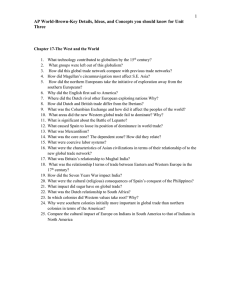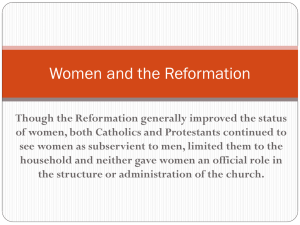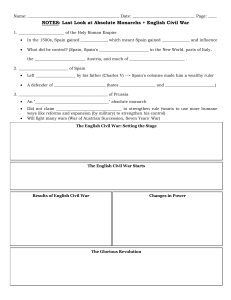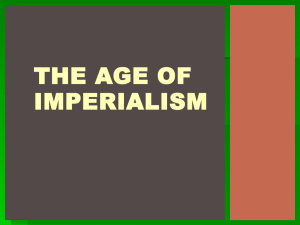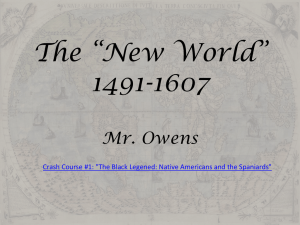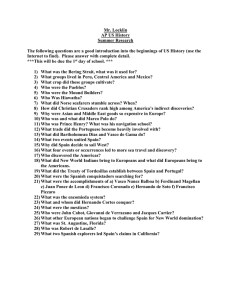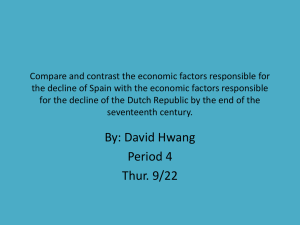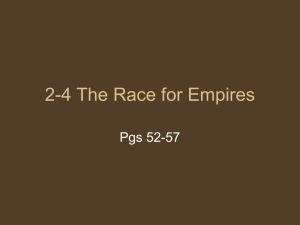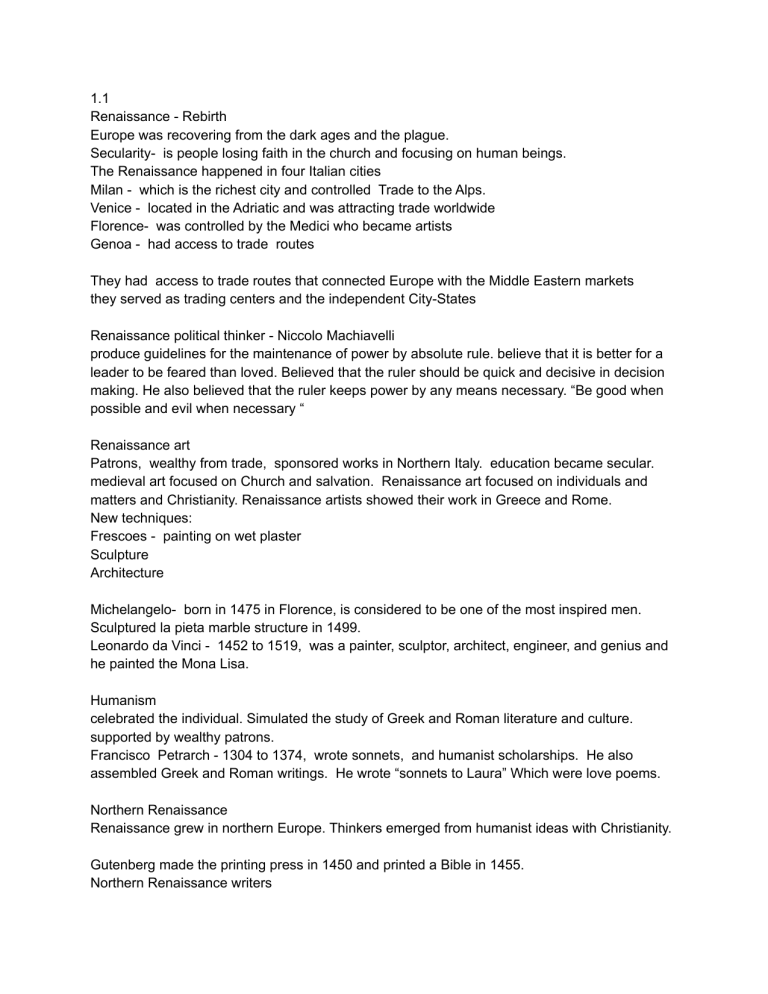
1.1 Renaissance - Rebirth Europe was recovering from the dark ages and the plague. Secularity- is people losing faith in the church and focusing on human beings. The Renaissance happened in four Italian cities Milan - which is the richest city and controlled Trade to the Alps. Venice - located in the Adriatic and was attracting trade worldwide Florence- was controlled by the Medici who became artists Genoa - had access to trade routes They had access to trade routes that connected Europe with the Middle Eastern markets they served as trading centers and the independent City-States Renaissance political thinker - Niccolo Machiavelli produce guidelines for the maintenance of power by absolute rule. believe that it is better for a leader to be feared than loved. Believed that the ruler should be quick and decisive in decision making. He also believed that the ruler keeps power by any means necessary. “Be good when possible and evil when necessary “ Renaissance art Patrons, wealthy from trade, sponsored works in Northern Italy. education became secular. medieval art focused on Church and salvation. Renaissance art focused on individuals and matters and Christianity. Renaissance artists showed their work in Greece and Rome. New techniques: Frescoes - painting on wet plaster Sculpture Architecture Michelangelo- born in 1475 in Florence, is considered to be one of the most inspired men. Sculptured la pieta marble structure in 1499. Leonardo da Vinci - 1452 to 1519, was a painter, sculptor, architect, engineer, and genius and he painted the Mona Lisa. Humanism celebrated the individual. Simulated the study of Greek and Roman literature and culture. supported by wealthy patrons. Francisco Petrarch - 1304 to 1374, wrote sonnets, and humanist scholarships. He also assembled Greek and Roman writings. He wrote “sonnets to Laura” Which were love poems. Northern Renaissance Renaissance grew in northern Europe. Thinkers emerged from humanist ideas with Christianity. Gutenberg made the printing press in 1450 and printed a Bible in 1455. Northern Renaissance writers Erasmus - wrote the praise of Folly in 1511. Was a Dutch humanist and used humor to show the behavior of people. Sir Thomas More - Utopia in 1516. Was an English humanist who believed in a perfect society. 1.2 Dutch and German painting introduced a new form of painting which was oil painting. examples are Durer, Brugeger, and Jan Van Eyck humanist writers Erasmus Thomas More and Shakespeare. the Elizabethan age - was named after Queen Elizabeth who ruled for 45 years. Shakespeare wrote during this time and explorers such as Sir Francis Drake decided to go on the exploration. The Renaissance allowed secular thoughts Rose Humanism has artistic Revival writers use everyday language in their books many inventions that were scientific happened exploration Desire grew 1450 - Gutenberg invented the printing press 1452 - Leonardo da Vinci is born 1469 - Lorenzo de Medici becomes head of Florence 1492 - Christopher Columbus discovered America 1498 - Vasco da Gama sailed around Africa 1509 - henry VIII becomes king of England 1509 - the praise of Folly is published 1503 - Leonardo da Vinci paint the Mona Lisa 1508 - Michelangelo begins His painting 1519 - Ferdinand Magellan sails the world 1.3 Reformation - questioning the church Martin Luther in 1517 criticized the church, and by 1580 five protestants had emerged from his ideas. Christianity was growing and had grown in ⅓ of Europe. Although there were ideas and people who rejected the church ideas byAbusing the catholic church/ Renaissance/ Political Climate/ Technology Innovation Abusing the Catholic Church There were uneducated priests, the church focused on finances, popes connected with politics, and the church needed money, so they did the following - Simony - selling church offices - Pluralism - one person leading many church offices - Absenteeism - Church officials ignoring duties. - Indulgence - selling “Get out of jail free” cards (Johann Tetzel) Renaissance Monarchs were impatient with church power. They provided more educated people. Humanism was based on spirituality. Translations of works from Latin to Vernacular (everyday language) Political climate - Henry VIII Was the king of England. Was married to Catherine of Aragon. She had one daughter and couldn’t bear more children. He needed a son to take on his heir. He needed to remarry but the pope didn’t allow him. - Charles V Was the king of the Holy Roman Empire. Was insecure and wanted to control more land. He was attacked by the French and the Turks. People preferred Martin Luther. Technology innovation Gutenberg’s printing press in 1450 helped spread the ideas of anti-church ideas and people started questioning the church. 1.3 part 2 Europeans reach AmericaThey expand geography, grow trade, bring diseases to Indians who live there, introduce slavery, and bring up the Columbian exchange (of food.) The countries that will fight for America are: Spain/ Dutch/ France/ Portugal Portuguese Were first to search water routes to Asia. Colonized South America (Brazil). - Prince Henry the Navigator (Coast of Africa 1419-1460) - Vasco Da Gama (India 1498) - Pedro Cabral (Brazil 1500) Spanish Started in the Caribbean and moved onto Central and South America. Had the first permanent colonies to what will become (USA). - cortez (Aztecs 1521) - Pizzaro (Incas 1531) - St. augustine (Florida 1565) - Columbus (West indies 1492) - Magellan (World 1522) - Ponce de Leon (Florida 1508) - Vasco De Balboa (Pacific 1513) - Fransica de Coronado (Mexico 1540) - Hernando de soto (Mississippi 1540) French Conquered Quebec and Montreal (Canada) and controlled the river St. Lawrence. Developed fur trade. - Cartier (St. Lawrence river 1535) - Samuel De Champlain (Quebec and Montreal 1608) Dutch Fur trade. Found Albany (New York). The Dutch and French form alliances with North America. - Henry Hudson (Hudson river, Netherlands 1609) Slave tradeExisted in Africa Portuguese replaced European slaves with African slaves. About 10 million Africans were shipped to the Americas. Encomienda system - Spanish practice of making a suitable and cheap labor supply ( just like European feudalism - providing people with land and taking labor - Soldiers controlled the Indian population (Indians paid tributes and gave personal services) - Soldiers in return had to ( protect them, teach them Christianity, defend their rights) - Encomienda eventually ended the Indian population - The king prevented Encomienda with laws supported by De Las Casas and the system eventually died out De Las Casas Believed Spanish treated native Americans harshly, believed Indians could be educated and Christianized, believed Indians were advanced European expansion Brought diseases,(PRICE REVOLUTION) economic climate, (COLOMBIAN EXCHANGE) of products, colonial rivalries. 2.1 Why did explorations happen? In the age of exploration (1450-1700) people wanted gold, money, spices, etc. The decline of the Mongols made it hard to get trade from the east. The fall of Constantinople to the Ottoman Turks made it even harder for the trade to be accessed through the east. The 3 G’s made the Europeans want to explore (Gold, Glory, God) Gold Gold was the wealth and the banking system for a country. It was believed that the wealthier a country was, the stronger it was. Glory They wanted the fame and the glory of exploration through humanism and the printing press. God Europeans wanted to spread Christianity across the world. Mercantilism - The more wealthy a country is, the stronger it is. Tools that helped explorationsCaravel ships, compasses, maps, sextants, and the bilge pump system, etc. Prince Henry from Portugal was the first to encourage explorations. Diaz - sailed around the Cape of Good Hope in the southern African tip. Vasco Da Gama - sailed to India Ferdinand Magellan - went around the world. Christopher Columbus - Found America 3.2 The Ming Dynasty turned China into a dominant power and established states in Korea. Hongwu drives the Mongols out of China and erases all Mongolian influence in china. He became the first Ming ruler and led Confucianism ideas in China. The government became Merit-based. His son, Yonglo, takes power after him and decides to go on seven different explorations to show off China's powers. Zheng He Was Muslim. He leads all of Yonglo’s expeditions. He distributed gifts to people and had tributes for china. China isolated itself to protest its culture. Foreign trade happened through the government even though there were some smugglers. Christian traders brought European culture along with them. Qing Dynasty Manchus invaded China and kept Confucianism, but expanded the Chinese borders. China had trouble with the British trade but accepted the Dutch trading. Manchus also attacked Korea and influenced Chinese culture and ideas of isolation. Life in China - Irrigation - Peace and prosperity - Grew more crops brought by Europe - Females were not valued - Both dynasties followed old traditions 3.3 “Japan” - the land of the rising sun Peaceful Japan began to shatter because of fights. Lords took over (this period was called Sengoku) These lords were called Daimyo, they built castles and fought each other. In early Japan, people worshiped gods, their religion is called Shinto, Shinto respected forces of nature (Kami), Kami believed in divine spirits of nature. Japan adopted Chinese writing/ culture/ art/ systems. Oda Nobunaga He fought and got the capital city, Kyoto in 1588. “Rule the empire by force.” His soldiers were samurai and used firearms. He couldn’t unify Japan. Toyotomi Hideyoshi Conquered all of Japan, invaded Korea, when he died his troops got out of Korea. Tokugawa Shogunate Unified Japan. Had daimyo loyalty. Became leader of Japan. Made the capital city Edo (Tokyo). He asked his sons to take care of the people, and protect the country. Japan lived two and a half centuries of peace. Society was very structured. Shogun/ military, Samurai who were powerful, Normal Samurai, Peasants, Merchants There were Confucian values in Japan. Many people left farms for town life. People attended ceremonial dramas, hung pictures of literature, had haikus (3 verse poems) They welcomed European traders, within a century, Europeans had outworn their welcome. Portugal brought things the Japanese didn’t have (clocks, glasses, tobacco). Japanese purchased weapons (swords). Samurai now use swords. They built forts. Castles attracted merchants. Xavier was a Christian guy who converted at least 100 people before he left. 300,00 Japanese became Christian which upset Tokugawa. He found Christians troublesome and ruined Japanese beliefs. Many rebels were Christian, so they started getting persecuted. The Japanese had to be Buddhist. They valued European trade, not ideas. Japan's borders were closed under the “closed country policy.” Nagasaki port was the only port open for trade. Only Dutch and Chinese merchants were allowed. Japan was closed for 200 years. Japanese were not allowed to leave. Europeans resisted trading with them and traded with Americans. 4.1 Christopher Columbus was born in 1451 in Genoa. He died in 1506 from an attack by natives He sailed for Spain even though he was Italian He went on four voyages in his lifetime Because Italy refused to give him permission to explore, he approached monarchs of Spain (Ferdinand and Isabella) First Voyage In 1492 he went to reach Asia by sailing west across the Atlantic ocean, he went with three ships - Nina, Pinta, and Santa maria in search of an alternate route to Asia. He landed in the Caribbean islands, Bahamas. He thought he reached the east indies (Asia) and called the native American Los Indios (Indians) and said that their land was for Spain. He named it San Salvador (Holy Salvador) Second Voyage Didn't find any gold in San Salvador and in 14937 he returned to Spain and the monarchs were pleased and agreed to three more tips. In September of 1493, he went with over 17 ships and over 1000 soldiers to turn all the Caribbean islands into Colonies. he went to Hispaniola and discovered the old colonies destroyed by natives Third voyage In his third voyage, he went to Trinidad and Venezuela in 1498. He wanted to transport convicts (prisoners) as colonists (immigrants) because of bad reports on Hispaniola and the novelty (being new) of the new world was wearing off. After transporting the convicts, Columbus saw a new continent but quickly went to check on Hispaniola. When Isabella and Ferdinand heard about the bad conditions in Hispaniola they sent a ship to bring Columbus to Spain in chains. Fourth voyage Columbus went to find an entry to Asia and Japan in 1502. Halfway through his journey, he stopped in Mexico where he was attacked by natives. During the attack, he left 2 of his 4 ships and went back to Spain, and then died. New world areas - North and South America Other explorers and their voyages- Pedro Carbal (1500) reaches Brazil and claims it for Portugal - Amerigo Vespucci (Italian) explored for the country of Portugal, sailed along the East of South America, and said that this wasn’t Asia, but a new world. - A German mapmaker named North-South America in his honor. - Captain Vicente Yanez Pinzon - captained the Nina -------------------------x-----------------------x--------------------Hernan Cortes attacked Mexico in 1521. Aztecs built a great empire in central Mexico. They built an empire through warfare and trade and created a capital city - Tenochtitlan in Mesoamerica Columbus was not the first to discover North America, the Vikings discovered it 400 years before. A Spanish explorer happened upon Florida when searching for the fountain of youth Europeans brought smallpox (deadly chickenpox) which killed millions of Natives (90% of the population) The Tainos were very friendly but Columbus took their gold. Some by force, and forced them to buy more gold. Spaniards used guns, which are no match for bows and arrows, horses (they were afraid), and smallpox, measles, and influenza. When the Spanish conquistadors explored the new lands, they looked for gold and spread the catholic religion. Hernan Cortes Was born in 1485 in Medellin, Spain. He was part of a noble family, in 1499, he attended University of Salamanca (law). In 1501 he gave up and joined the army under the command of Diego Velazquez and helped him conquer Cuba. It made him the perfect candidate for the governor’s expedition to the mainland in 1519 (Mexico) His journey Montezuma II believed that Cortes was a god because of his resemblance to a god. He sent him gold, and Cortes wanted more gold, so he went to Montezuma. When he came to Tenochtitlan he put them to an end and met Malinche. Cortes took Montezuma as a prisoner, they drove the Spanish out, but they killed Montezuma. No one knows how Montezuma was killed, he could have been killed by Spaniards or Aztecs. He returned in 1521 and defeated the Aztecs and killed them. Malinche “La Malinche '' - Aztecs, “Doña Marina” - Spaniards, was the wife of Hernan Cortes. She was called a traitor for marrying Corte, and she converted to Christianity. She gave cortes a son “Don Martin Cortes'' The defeat of the Aztecs ------------------------------x---------------------------x----------Inca was in Peru Atahualpa was the inca emperor Manco Capac is the founder of the Inca society Fransisco Pizzaro is the spanish conquistador (conqueror) Peizarro was the second cousin of Cortes; he was poor. He joined the military ad explored the new world He gained the trust of many explorers South- American explorers would bring back tales from a rich gold country called Peru He went to Ecuador and Peru (1519, 1532) He encountered a group of natives called Incas in Peru Incas They were the largest group of natives in the new world. The population was 40 million before the Spanish. They were known for building roads and fortresses. “ Romans of the new world” were also very wealthy, they made their household after precious metal. Incas had no writing system but a knotted string or rope called Quipu to calculate. They had human sacrifices and even left babies on mountains and they would die. They would be called natural mummies. Pizzaro Pizzaro tried to negotiate with Atahualpa, but he refused. So Pizzaro attacked and captured him and told the Incas to fill a room with gold. When they did, he killed him anyway. He took the gold and defeated the Incas in their capital city “Cuzco” and killed them all. He wanted to make a capital city but it was too far, so he created a new one called “Lima” on the coast. Smallpox killed 93% of the Incas the rest were enslaved by the Spanish Pizarro made Spain a very rich country and was higher than Cortez in terms of conquests 4.2 Dutch, English, and French have colonies in North America The french Samuel De Champlain conquers Quebec (Canada) and names itNew France Is an enormous land with few people that focused on the fur trade. English Their king (James) allowed people to start a colony. In 1607 they found a colony (Jamestown) in Virginia. Many people died but the colony survives. England Pilgrims - people persecuted because of religion (Plymouth 1620) Puritans - people seeking religious freedom (Massecheutes) Families in Massachusetts grew rapidly. Dutch Henry Hudson explored waterways for the Dutch in 1609. He claimed New Netherlands (now Albany and New York) They focused on the fur trade and allowed non-dutch people to live in their colonies. Caribbean Europeans also settled in the Caribbean. They had cotton and sugar plantations by African slaves. English vs Dutch The dutch colony New Netherlands was separating the English colonies into northern and southern, so in 1664 the English surrendered the dutch and in 1750- 1.2 million people arrived in North America. English vs French The English wanted more land so they attacked the French and in 1763 the French gave up their land to the English. French and Indian war( seven years war). Native people French and Dutch get along well with natives English disagree with natives over religion and land Fights break out, natives get infected by European diseases, so they get slaves from Africa to work. 4.3 Between the 1500s and the 1800s, millions of Africans were captured and shipped across the Atlantic ocean and sold as slaves. European planters needed workers on sugar and tobacco plantations Planters first used native Americans, but they died quickly because of the diseases. They were also used as indentured slaves (paid for) which made them very expensive. So Europeans turned to African slaves. African Slave Trade Millions were forcibly taken to America. Most of them came from West Africa. Some were exchanged for guns and others were kidnapped by traders. Captured Africans became a part of the triangular trade. Triangular trade The first leg - ships carried European goods to Africa to be exchanged for slaves The second leg - Middle Passage - Africans were brought to the Americas to be sold The third leg - American products were carried to Europe Middle Passage Captive Africans were chained together, forced into dar, below ships’ decks. They could neither sit nor stand. The journey lasted 3 to 6 weeks. 10-20% of them did not survive and died. They were used for Spanish- Caribbean sugar plantations They worked in the countrysides, domestic, towns, mines, plantations They lived a very harsh life and were verbally abused Many slaveholders lived a constant fear that slaves would rebel Laws in America didn’t allow slaves to have rights, freedom, and considered them to be property Resistance Many resisted by→turning to religion→keeping culture alive→slowed work→destroyed equipment→flee→revolt→runaway The Slave trade lasted for 400 years It was a very profitable trade for Europeans 15 to 20 million Africans were shipped against their will African spread called Diaspora Enslaved Africans had the ability to gain freedom in the Muslim Society 4.4 The colonization of the Americas introduced new items into the eastern and western hemispheres Old world - Asia, Africa, and Europe Columbian exchange Trade of plants, animals, ideas, weapons, and diseases between the new world and the old world. Llamas were the only animals in Latin America. Europeans brought horses, pigs, cattle, and sheep. It changed the use of the land. They brought sugar, rice, wheat, coffee, bananas, and grapes. Europeans adopted maize (corn), tomatoes, potatoes, tobacco, cocoa, beans, and cotton. They spread diseases such as smallpox, measles, Diphtheria, and chickenpox. Illness in Europe was considered a consequence of sin. The Inca Empire decreased from 13 million to 2 million in 8 years. Mercantilism is a theory where a country’s power depends on its wealth. Joint-stock companies - a company whose stock is owned jointly by the shareholders. Pandemic- diseases that spread over a large area or worldwide Endemic- diseases found in a certain area 5.1 Absolutism - one person holds all the power Monarchs grew with the decline of feudalism - Church lost power - Monarchs gained control - Middle class backed monarchs Absolutism is Basic principle (divine right) Political (unlimited power) Social (Upper class rules lower class) Economic (industry and trade) Cultural (culture) Philip II - Reigned for 42 years - Ruled spain, new world, parts of italy and netherlands - Catholic - Spain went bankrupt 4 times - Gold and silver came from the new world - Lost to elizabeth, dutch and ottomans - Used spanish navy against catholic enemies - Wanted to marry elizabeth - Wanted to make england catholic The Spanish armada (navy) was defeated by- English artillery ()مدفع - English unconventional tactics - English used protestant wind and fire ships Escorial - village in Spain - Counter reformation - Keys weigh ½ a ton - 86 staircases - 1,200 dors - 84 miles of corridors - Hidden window from philip’s window to church Hapsburg’s patronsEl Greco, Velaquez Novel writer Miquel De Cervantes wrote Don Quixote Weakening of empireEconomy - inflation rose No modernization Dutch revolt 5.2 Absolutism in France rose when Louis XIV was crowned in 1643 He punished nobles and reduced nobility power Louis XIV was known as the sun king, he came to rule when he was young and was taught. When his minister died, Louis declared “I am the state” and decided to rule everything He declared divine rights and absolute monarchy lasted for more than a century. He was incharge of everything. GovernmentHe built a palace at Versailles and demanded all nobles live there. He also urged them to develop expensive habits of dressing, dining, etc. They grew poorer, and had to rely on the king. He had special ways (fancy) of walking, dining, dressing, etc. He chose the sun as his symbol. He became God's representative on earth. Religious unificationHuguentos (against religion) Edict of Nates (Law allowing huguenots) Louis revoked Edict of Nates, Many huguenots fled (they were skilled.) Loss of their skill caused a financial issue. Louis was the most powerful king of Europe. He led France to war 4 times. He had a mercantilist system and needed a lot of money to be able to afford his lifestyle. 5.3(1+2) Wars of religion Catherine Medici was trying to keep everyone happy. St Bartholomew's Day was Huguenots day. Henry IV returned France catholic. The Edict of Nates gives protestants freedom. Mary Tudor is super catholic and becomes bloody mary by executing hundreds of protestants. Phillip II loses the Netherlands. England has tensions against Spain because they support the Netherlands. Elizabeth I attempts to tolerate religion. The Spanish army was defeated by the english. The house of hapsburgAre a family that has grown to the control of Austria and Spain (mainly). ALso, by marriages, they grew to the control of Hungary, Spain, Bohemia, Austria, etc. Peace of augsburg is a treaty that brought an end to the fight between german catholics and lutherans. They didn’t recognize calvinists, although there were many. Germany - political defragmentation (breaking up) In palatinate - alliance formed between calvinists, england, france, and netherlands (protestant union) Lutherans feared them now as well. Duke Maximilian of Bavaria organized a catholic league of german states and spain. Four phases- bohemian phase, danish phase, swedish phase, french phase Bohemian phase King Ferdinand II revoked a;; religious freedoms of protestants so protestants set up meetings with catholic officials. They fought and tossed two officials out of the window. This was known as “defenestration of prague.” Then the catholic and protestants began fighting. Protestants used forces (Czechs) and removed Ferdinand and chose Frederick V, head of the protestant union. Ferdinand used the funds from the catholic church and spain to build an army. The cathloic crushed the protestants at the battle of white mountain. Danish phase Soldiers wanted to make money during the war. Wallenstein was a czech protestant, now on the catholic side. He offered his services to the emperor and the emperor commissioned Wallenstein and his army. His men unleashed destruction in germany. Enemies were horrified from wallenstein.After the catholics won, the emperor made “the edict of restitution”, it made calvanisim illegal, the edict restored all lands taken by protestants. German princes feared and forced the emperor to remove wallenstein. Swedish phase King gustavus wanted to help the protestants and succeeded in the north so the emperor asked for wallenstein’s forces again. Gustavus died in the hands of wallenstein’s forces. Ferdinand assassinated Wallenstein because he was distrustful of him. French phase The French entered the war on the protestant side. No one wanted to knock the other out so the fighting dragged on for 13 years. Germans were too disunited to drive the Spanish, French and Swedish out. ⅓ of the German population died. Peace of westphalia War ended in 1648, the treaty allowed Calvinism, and banned that the catholic would rule most of europe. The treaty also cancelled the edict of restitution. The north remained primarily protestant and the south remained catholic. Europe was divided into equal states. France became the most powerful nation. The German population, homes, and farms were destroyed. Strong cities emerged in central europe. Economy was different from western europe. In the west serfs moved to towns and became middle classed. Central Europe wanted serfs to remain on farms and sell excess harvest to western europe. Central Europe blocked strong kings. The Ottoman empire has already expanded as far as possible. The Holy Roman empire was weakened. In Austria, hapsburgs tried to become absolute monarchs. They conquered bohemia, and created an army and took Hungary from the ottomans. The Austrian king, Charles, put his daughter, Maria Theresa, incharge of his kingdom after him. Her main enemy was prussia. She decreased the power of nobility and was mom to Marie antoinette. Prussia rose to power, and had a leading family “hohenzollerns” who controlled small german states. William was incharge of brandenburg. He needed a strong army, and created an absolute monarchy. And the strongest army in europe. William worried that his son was not strong enough to rule (he loved music, poems and philosophy, and tried to run away with his friend) so his father beheaded his friend. He followed in his father’s path. Fredrick wanted prussian land but underestimated maria’s power. Maria stopped the Prussians but because of a treaty the land was taken by the prussians. Maria made an alliance with france (france, russia, austria) Frederick signed a treaty with Britain (britain, prussia) Frederick attacked an Austrian ally. Britain got France's colonies. Prussia emerges as a European power. 5.4 Ivan III declared self control over Moscow. He resisted Mongols. He depended on loyalty from boyars (class next to leaders). Princes of Moscow believed that there were heirs for Constantinople (czars). Ivan married the last Byzantine emperor's daughter. Ivan IV pushed advisors. Killed mongols, boyars, and anyone against him. “Blue blood” the last “Ruik” czar died without children. “Smuthoya Vremya” was a war between boyars. Poland and Lithuania also invaded. Alexi (a boyar) ruled. He had 5 sons and only one (Ivan) survived until adulthood. He was mentally unstable. He married a second wife and had a son named Peter. Peter and Ivan became co-czars with the help of their sister Sophia. Peter grew up in the west and away from Russia. He was fascinated by the west and decided he could rule without Sophia. He forced his sister to become a nun and died. His brother also died. He wanted to become an absolute monarch, he weakened the boyars and took away private armies. He also westernized Russia (clothing dancing). Peter forced nobles to serve in the army. He created schools and universities. He increased the military size. He also had protestants do labor. He built churches and improved education (Math, science, music). He improved travel, mining and modernized Russia. Peter’s first wife and son revolted against him. He needed a port for Russia. He decided to attack Sweden and take their port. He built a strong military and took the port. When he died, his wife took after him. 6.1 From 1550 to 1700 Europe experienced a scientific revolution in the fields of biology, physics, astronomy, and anatomy, which changed Europe’s perspective of the world. Scholars began using the scientific method to find answers to questions. People began to question everything and nothing was assumed to be true. The scientific method- Observation - Questions - Hypothesis - Prediction - test If the test agreed with the hypothesis more prediction was made and more tests would be conducted If the tests did not go with the hypothesis it was either altered or a new one was proposed ★ Nicolas Copernicus - had a theory of heliocentric, which meant that the earth and other planets revolved around the sun and, not around the earth. This changes Europe’s view of the universe and led to modern astronomy Johannes Kepler - proved heliocentric mathematically. Said that planets moved in an elliptic way and not always at the same speed. Galileo Galilei - improved the telescope and researched the stars and the moon. Perfected the scientific method, and created the law of inertia. Isaac Newton - had the theory of gravity, studied the physics of light, motion, and heat. Created calculus to prove his theories. William Harvey - was an English doctor that proved the flow of blood throughout the body and that it was being pumped by the heart. Andreas Vesalius - added to European science in more than 1500 years. Was the start of modern-day science. 6.2 Old idea: a monarch’s rule is defined by divine right New idea: Government’s power comes from the consult of the governors. Old idea: Scholars rely on ancient beliefs and church beliefs to explain the world. New idea: Scholars use the scientific method to explain the world. Old idea: The state and the citizens existed to serve the monarch New idea: The monarch existed to serve the state and the citizens Since the scientific revolution caused an era of questioning everything, people began to question monarchy and the government. Enlightenment ideas(philosophes believed): ★ - The universe could be defined by reason - Everything could be explained by natural laws - The universe can get better and improve - People have natural rights to be free. Enlightenment despots - monarchs who had absolute power and used it mainly in an evil way. Thoma Hobbes “People can’t be trusted. Kings should rule!” - Believes that humans are naturally violent - Need a king - Should sign a contract to give up their freedom in exchange for the king’s protection. John Locke “People are good. They have rights and should overthrow the government when kings abuse power” - Believed that people are naturally good - Can break the “contract” when needed - The best government has limited power and listens to people Voltaire “Don’t be a hater! People should be allowed to say anything they want, even if you don’t like it” - People have freedom of speech - Demanded french leader have more tolerance - Fought for prejudice Baron De Montesquieu Giving one person all the power is a bad idea” - Believed that power should be split up and balanced. - Legislative makes laws - Executive enforces laws - Judicial interpret laws Jean Jacques Rousseau “let’s make a government that benefits the majority of the people” - Believed that people are naturally good but power corrupts them - The best form of government is direct democracy - People are ruled by the general will Fredrick II the Great of Prussia “First servant of the state” - Abolished torture - Granted religious freedoms - Reduced censorship - Improved Education and Justice systems Catherine II the great of Russia - Tried to modernize and reform Russia - Tried to free serfs and stop torture and death penalty (but failed) Philosophies encouraged people to judge for themselves people relied on reason to solve problems ideas lead to violent revolutions in America and France American philosophies John Adams ( 1745 - 1826) Ben Franklin ( 1706- 1790) Thomas Jefferson ( 1743- 1826) Thomas Jefferson - Wrote the declaration of independence in 1776, Best of John Locke’s ideas - Explained the American Revolution reasons 6.3 Enlightenment ideas were spread by - The salons of Paris ( philosophers, writers, artists, scientists gathered and discussed enlightenment ideas) Diderot’s encyclopedia (One book that contains parents ideas about science and art and the government) Media ( books and newspapers and magazines were bought by the middle class) art and literature The neoclassical style replaces the baroque style in the 1700 (Example- Beethoven, Mozart, and Hayden) The new form of writing called the Novel becomes popular ( and stories told to the middle class, for example, Tom Jones and Pamela and Robinson Crusoe) - Painters now look for inspiration in nature and Society and silence and individualism. Enlightenment governors ★ Frederick II the great of Prussia Joseph II of Austria ( granted the freedom of worship and tried to get the freedom of serfs) Catherine II the great of Russia ( expanded the Russian empire and got a port on the Black Sea from the Ottoman Empire) 6.4(1+2) The seven years war aka the french and indian war (france and indians vs. british) for land The British won but it cost a lot of money so they made taxes. “Sugar Act of 1764, and the Stamp Act of 1765 placed taxes on sugar exports and newspapers/ playing cards. Colonists were upset. Colonists said “no taxation without representation” because they had no rights in the government. They started a boycott to buy British goods. Samuel Adams ★ Led the boycott in Boston. He began a secret society called “Sons of Liberty” Sons of liberty used violence to scare the tax collectors off. More taxes on glass, oil, pain, paper, etc were added. This rebirthed the chaos caused by the Stamp Act. Men insulted the British army.Someone yelled “fire” and the Red Coats (British Army) shot 5 people. Sam called this the Boston Massacre. He made people hate the British. Colonists dressed up like Indians and boarded 3British ships full of tea. They dumped the tea into the harbor. King George III was mad. Government now taxed tea. They didn’t drink any more tea. The post of Boston was closed until colonists paid for all the tea. The Quartering Actforced colonists to house and supply the British soldiers. The “tea party” also happened in Charleston, New York, Annapolis, etc. Important men met to discuss. They set up Militias (soldiers). The British hoped to capture Samuel Adams in Lexington and supplies in Concord. The first shot was called “The shot heard around the world.” A second meeting was hosted in philadelphia. George Washington became head of continental army. Battle of bunkerPatriots needed to get a breed's hill so they could fire British soldiers in Boston. They lost the battle but they killed many soldiers. They needed allies to give them gunpowder and assistance. “Common sense” Was a book written by Thomas Pain which encouraged colonists to become independent from Britain. Thomas Jefferson wrote the declaration of independence on July 4, 1776. The declaration listed the ways King George abused power. Whoever signed was seen as a British traitor. The declaration also stated “All men are created equal” but they didn’t treat native Americans and slaves equally. Benjamin Franklin was sent to France to ask for military as well as a loan. Battle of Saratoga Britain wanted control of the Hudson river but their army was suffering. France won and agreed to help America against Britain. Siege of Charleston The British attempted to capture Charleston. They didn’t win at first but got it in the second attempt. Battle of cowpens Partisan forces fought when the British came close to them. Battle of Yorktown ★ Greenes’s army came from the south while George’s came from the North. The French blocked the harbor. The British army was defeated. The treaty of Paris recognized the US as a free and independent nation. America first set up a government and it failed. They then created a new constitution under enlightenment political ideas. The federal government constitution was divided into three branches of government. lEaders feared too much national power and added a bill of rights to support the constitution. The bill of rights slowly gave everyone the right to vote. 7.1 First Estate Second Estate Third Estate 1% of the population 10% of the land clergys 2% of the population 25% of the land nobles 97% of the people 65% of the land Middle class, peasants, bourgeoisie Hereditary system No taxes Great style No taxes Privileges Income from peasants Pays ½ of their income as taxes This kept them on the king’s side The government gave US $6 million to fight England: Against the king 50% - loans to America 25% - military 6% - king’s lavish lifestyles Inflation and crop failure rose due to debt and led to starvation. Marie Antoienette and Louis XVI were too young and made bad decisions. When meeting, 1st and 2nd estates voted against the 3rd estate. The 3rd estate left and formed a national assembly. Changing government - Social protests - Political actions - Revolutions French revolution“Storming of the Bastille “(bastille is a jail where political prisoners are held). 3rd estate storms jail and frees prisoners. July 14 is the beginning of the French revolution. “Declaration of the rights of man and citizens.” gives equality to all but Louis rejects it. “Tennis court oath” is where the 3rd party sets up the national assembly. The king orders the 1st and 2nd estate to join so that the 3rd estate won’t revolt. “March on Versailles” is a protest where women marched and demanded the king move to Paris and accept the declaration. Louis was jailed and executed “Constitution of 1791” made France a constitutional monarchy. Everyone was equal. There were 3 parts of the assembly, those who had big changes, those who accepted some changes, and those who accepted none and wanted the old system. Jacobins Starts to gain control and wants a republic. Austria and Prussia declare war on France. He executes anyone related to monarchy as well as traitors. Many innocent people were killed. Death ended violence. A big gap between the rich and poor grew. 7.2 The assembly adopted the declaration of “The rights of man and of the citizen” “Liberty, Equality, Fraternity” This didn’t apply to women, so “Olympe de gouges” was executed as an enemy to the revolution. The assembly solved financial problems by taking the church land. The actions of the assembly worried the peasants, who were catholic. The royal family flees to Austria and revolutionaries catch them in Varennes. The assembly finishes its new constitution and decides to keep a limited monarchy. Power was transferred to the legislative assembly. The legislative assembly entrenched the left-right policy. Left Radicals Middle Moderates Right Conservatives Left wing; left side of the hall Centrists; center of the hall Right wing; right side of the hall Wanted a lot of changes to the government and suggested people hold power. Wanted some government changes. Wanted limited monarchy and few changes in the government. Problems like debt, food shortages split France into radicals, moderates and conservatives Emigres are nobles who fled the country and want the old system. Sans- culottes (without knee breechesL were lower class who wanted more change from the revolution. Austria and Prussia wanted Louis XVI incharge of france. European monarchs were afraid revolution would spread. France vs. Austria + Prussia (war) Prussia threatens to attack Paris A Parisian mob jails the royal family and kills guards. Mob breaks into prison and kills more than 1000. Mob also pressures the legislative assembly to leave. National convention takes over. Jacobins Was head of the radicals who wanted to change the government. Louis was found guilty of treason and beheaded. The French inherited the Guillotine (chead cutting machine) which was only used on aristocrats. War continuationFrance wins Britain, Spain and Holland join together against france. Maximilen robespierre Nickname “incorruptible” Tried to build a republic of “virtue” He changed playing cards to remove the king and queen. He removed sundays He closed all churches Thousands were killed because they were “enemies” They were all executed. They beheaded Marie Antoinette. The guillotine was so slow, they started firing and drowning people. 85% were the third estate. Robespierre was executed Radicals opinion was ignored They created a new government with Napoleon Bonaparte as commander.
